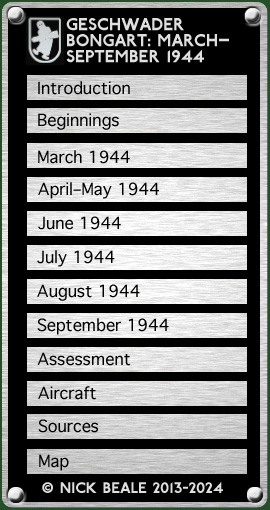|
The German position in the French interior seemed to worsen by the day, the Abwehr sub-station in Limoges reporting: Situation more acute. German bomber shot down 35 km from Limoges. The Maquis are at 6 km distance round Limoges where French police and Militia have been concentrated. It is incomprehensible that no assistance has been sent. Clarification is requested. That “German bomber” may well have been the Reggiane at Jumeau-le-Grand (see above), although the distance from there to Limoges is nearer 30 km. At its HQ at Rouffiac-Tolosan on the eastern outskirts of Toulouse, Armeegruppe G recorded in its diary: Geschwader Bongart (Bourges), which is deployed under Luftflotte 3 in Central and Southern France to reconnoitre and attack terrorist organisations, initiates liaison with the Armeegruppe. It can operate in the Armeegruppe area with one Zerstörer and one bomber Staffel. The A.Gr. issues an order to subordinate units advising that for clearly recognised and worthwhile targets, Luftwaffe requirements can be put to the A.Gr. Ia [Operations Officer]. The order itself explained how air support was to be requested: Air support has been made available to the Army Group for combating terrorists. requests for [its] employment are to be directed to the Army Group’s Operations Officer. They must be submitted, at the latest, by noon on the previous day. Apart from that, it is envisaged that on each occasion an officer will be detached to the airfield with the precise documents and mission for the bombers. Details will be ordered case-by-case. Calls for air support are only to be submitted in cases where the targets are definitely identified and worthwhile. In no circumstances must there be any misses. On the far side of Toulouse that morning, Hptm. Roderich Cescotti of Stab IV./KG 100: … received the order to undertake an anti-partisan mission. At 0530 hrs. [GMT + 2] I took off from Francazal to operate in conjunction with ground troops against a Maquisard camp in the Pyrenées. I dropped two 500 kg bombs. There were other actions of this kind, such as an attack on a village where we dropped a tonne of incendiary bombs on two barns and a farm. My plane took some hits attributable to shots from the ground. I don’t really know how many operations of this kind took place since I had become the unit’s TO (Technical Officer) and I was often absent, forced to shuttle back and forth to Germany bringing in new aircraft or spare parts.
20–21 June The III./SG 4’s Gruppenkommandeur, Maj. Gerhart Weyert, flew from to Bourges to confer with Oberst Bongart, “who leads the Luftwaffe’s fight against the partisans”, before joining his unit at Clermont-Ferrand where 19 of its aircraft had now arrived. There were complaints that this new base was not big enough and that too few blast bays were available to protect their Focke-Wulfs. Conversely, the base command reported next day that it could supply III./SG 4 with bombs from existing stocks. Meanwhile the newcomers investigated the dispersal of some of their aircraft to other fields but considered none of them suitable. On the 20th, German aircraft supported the assault on the Maquis redoubt of La Truyère in the Auvergne; it had been set up by the Revanche (Revenge) group under Henri Fournier. The first bombing and strafing took place at 15.00 local time and three hours later the villages of Anterrieux, Saint-Martial and Pradel (Lavigerie) were practically destroyed by air and ground bombardment. “Colonel Charles” of the Limousin FFI was on the receiving end: The spotter plane is watching the area, the enemy attack can’t be far off. Indeed the alert is given at 09.00 [local] on 20 June … Towrds noon … Anterrieux finds itself under fire from German armour. We have to pull out under a hail of bullets and mortar bombs [and] then 50 kg bombs that four bombers with black-crosses drop on us … Around 17.30 hrs. a squadron appears at low altitude and begins a hellish dance above us. For forty minutes we are inundated with bombs, shells and machine gun bursts. At last the planes depart and we establish that we just have some wounded. At 20.00 hrs. the order arrives for a general withdrawal through Albaret-le-Comtal. We pass close to garage installations which bear the marks of a recent and violent bombardment. The planes have been here too. During the afternoon »Zugvogel« (= migratory bird, a callsign of Kampfgruppe Jesser or one of its elements) notified Abel West that aerial reconnaissance had seen a tented camp with approximately 100 motor vehicles 1.5–2 km to the south west of Chaudes-Aigues in the Cantal département and that the Luftwaffe would be attacking it; another formation, Gruppe Cölle, was notified of a tented camp near “Martial” (possibly Saint-Martial, Creuse). An intercepted supply return of the 21st showed that 26 x AB 250 canisters filled with SD 1 fragmentation bombs had been issued to Châteauroux, where 12./Geschwader Bongart was based, and that the IV. Gruppe had received 6 x 250 kg and 12 x 50 kg Italian bombs. ZG 1 was again active, Obltn. Bellstedt recording anti-artisan operations on both the 20th and 21st. During the morning there was reconnaissance of St. Flour (85 km south of Clermont-Ferrand) “for combatting bandits”. During the morning there was reconnaissance of St. Flour (85 km south of Clermont-Ferrand) “for combatting bandits”. continued on next page …
|
|||

